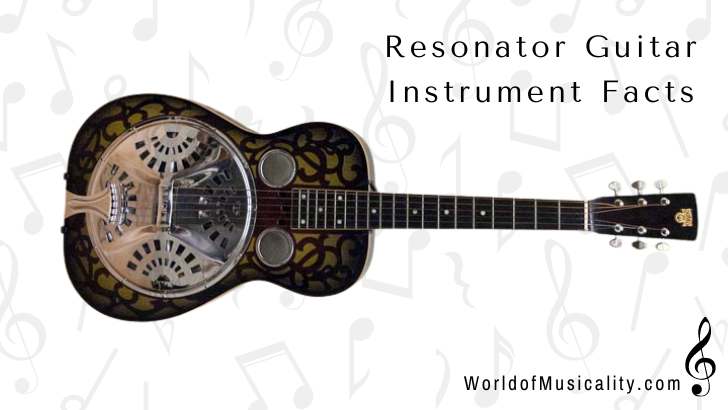
Resonator Guitar Description
The resonator guitar is a distinctive six string guitar instrument known for its loud, metallic sound produced by one or more metal cones (resonators) inside the body.
It is played similarly to an acoustic guitar but is often used in genres like blues, bluegrass, and country for its unique tonal qualities.
Detailed Instrument Description
| Instrument Name | Resonator Guitar |
| Instrument Family | String |
| Alternative Names | The resonator guitar is also known as a “resophonic guitar.” Depending on its design and the number of resonators, it might be referred to as a “dobro” or simply “resonator.” |
| Geographical Presence | The resonator guitar is a popular guitar played worldwide, with a significant presence in American blues, bluegrass, and country music. It is also popular in European and Asian folk and contemporary music scenes. |
| Instrument Classification | The resonator guitar falls under the Hornbostel-Sachs classification system as 321.322, identifying it as a plucked chordophone. This system classifies musical instruments based on how they produce sound, with the resonator guitar classified as a chordophone where sound is produced by vibrating strings. |
| Unique Features | The resonator guitar is unique for its use of metal cones (resonators) to amplify sound, instead of the traditional wooden soundboard of acoustic guitars. The instrument often features a metal body or a wooden body with a metal resonator plate. |
| Sound Characteristics | The resonator guitar produces a loud, bright, and metallic sound with a distinctive resonance. Its tone is more focused and penetrating than that of a traditional acoustic guitar, making it well-suited for slide playing and genres requiring strong projection. |
| Typical Music Genres | The resonator guitar is primarily used in blues, bluegrass, and country music. It is also found in folk, jazz, and various other music genres, adding a unique tonal quality and volume to performances. |
| Components | Body, Neck, Fingerboard, Strings, Tuning Pegs, Bridge, Soundhole, Resonator Cones, Cover Plate, Tailpiece |
| Construction | The resonator guitar is typically made of wood or metal. The body can be entirely metal or a combination of wood and metal. It includes one or more metal cones (resonators) inside the body that amplify the sound. The neck is usually made of wood, and the fingerboard can be wood or synthetic material. |
| Size and Weight | The size of the resonator guitar varies, but they typically range from 90 to 100 centimeters (35 to 39 inches) in length. The weight can vary significantly, with metal body guitars weighing up to 6 kilograms (13 pounds) and wooden body guitars being lighter, around 3 to 4 kilograms (7 to 9 pounds). |
| Variations and Customizations | Variations of the resonator guitar include single-cone and tricone designs, square necks for lap-style playing, and round necks for standard playing. There are different types of resonator guitars, including single-cone and tricone models. Single-cone resonators have one large cone that amplifies the sound, while tricone models have three smaller cones, which provide a different tonal quality and projection. Customizations also include wood or metal bodies, finishes, and decorative inlays. Some models also feature pickups for amplification. |
| Instrument History | The resonator guitar was invented in the late 1920s by John Dopyera to create a louder guitar sound that could be heard in ensembles before electric amplification. It became popular in the 1930s and 1940s, particularly in blues and country music. The Dobro brand, a contraction of “Dopyera brothers,” is one of the most famous makers of resonator guitars. |
| Similar Types of Instrument | Steel String Acoustic Guitar, Lap Steel Guitar, Weissenborn Guitar |
| Playing Technique | The resonator guitar can be played with a slide or traditionally with fingers or a pick. Slide playing involves using a metal or glass slide to press the strings, producing a smooth, gliding sound. Fingerstyle and flatpicking techniques are also common, depending on the genre and player preference. |
| Notable Composers | Bukka White, Son House, Jerry Douglas |
| Famous Works | White’s “Shake ‘Em on Down,” House’s “Death Letter Blues,” Douglas’ “The Boxer” |
| Maintenance | Regular maintenance includes cleaning the instrument, tuning the strings, and occasionally replacing strings. The resonator cones and other metal parts should be kept clean and occasionally polished. Proper storage in a case or on a stand is important to protect the instrument from damage. |
| Learning Difficulty | Moderate; requires coordination to manage slide and finger techniques simultaneously. Learning proper slide control, picking techniques, and music reading are essential for effective playing. |
| Prominent Players | Jerry Douglas, Bonnie Raitt, Ry Cooder |
| Notable Performances | Notable performances include concerts by prominent resonator guitarists at major venues and festivals worldwide, such as the Telluride Bluegrass Festival and the Crossroads Guitar Festival. |
| Famous Orchestras/Bands | Prominent bands featuring the resonator guitar include Dire Straits, Alison Krauss & Union Station, and The Rolling Stones. |
| Price Range | Resonator guitars range from $500 to $3,000 or more, depending on the craftsmanship, materials, and features. Beginner models start around $500, while professional models with custom features can exceed $3,000. |
| Interesting Fact | The resonator guitar was invented to provide more volume before electric amplification was available. |







